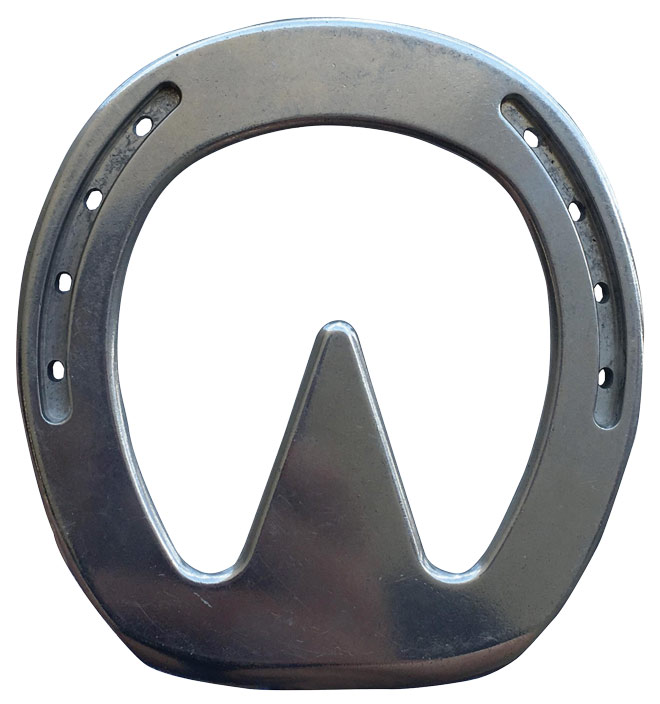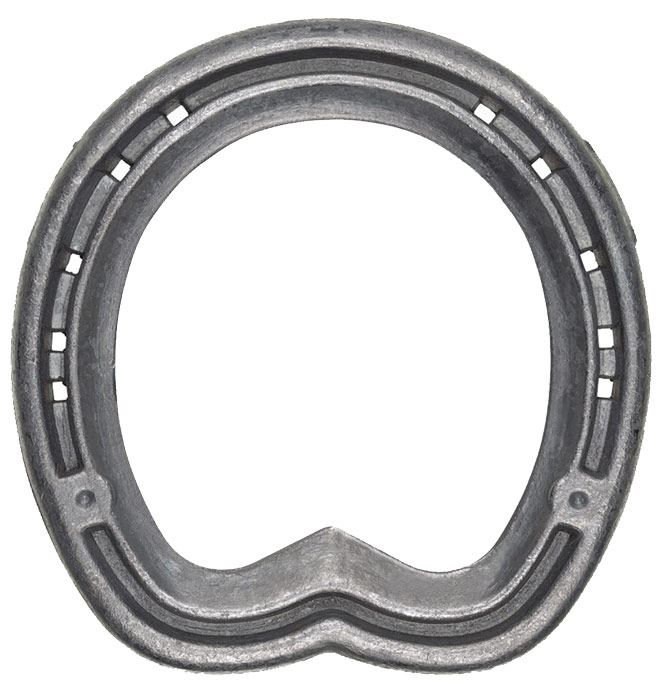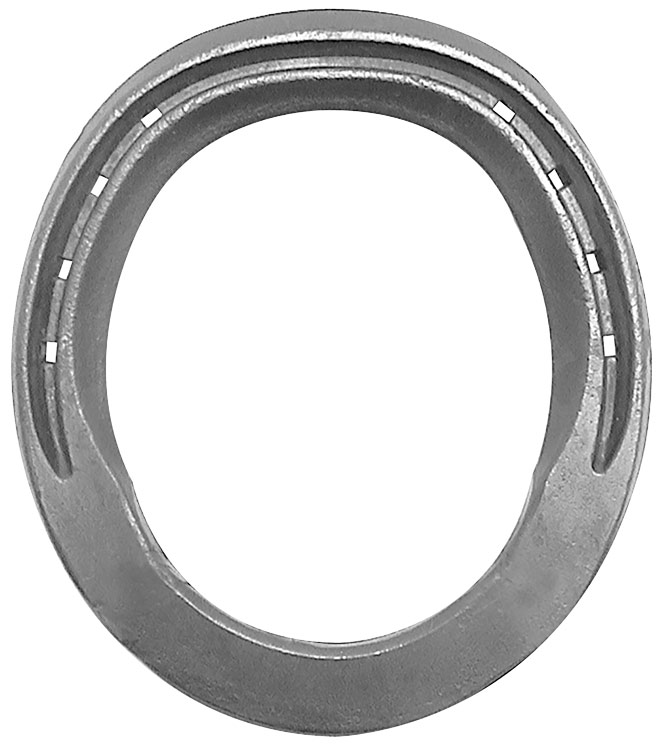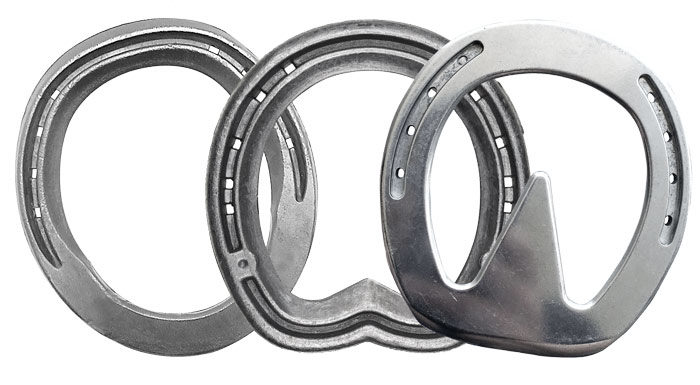There is no shortage of horseshoes, in size, style or material. It will take no more than a few minutes inside a well-stocked supply store to convince anyone of that.
Jeff Ridley, a farrier from Leighton, Iowa, recently was struck by that fact during a clinic at Anvil Brand’s headquarters in Lexington, Ill. The clinician was Shayne Carter of West Mountain, Utah.
“The place is huge,” recalls Ridley. “And everyone wants to see Shayne forge a shoe, because that’s what he’s known for. But Shayne told us, ‘In all honesty, if you can’t find a shoe to fit one of your horses in this building, you’re in trouble.’ We have such a huge variety and so many options available to us. It’s just amazing.”
But all those choices and options also present a challenge to the hoof-care professional. Choosing the right shoe for a particular horse and need isn’t always easy. Interviews with several experienced farriers reveal a consensus that mistakes usually are not a matter of choosing a “bad” shoe, but rather using a good shoe incorrectly.
Farrier Takeaways
Experienced farriers believe that selecting the correct shoe for a horse is based on a variety of factors.
It is important to develop an understanding of what the particular design of a shoe can and cannot do to help a horse.
A thorough examination of the horse, the work it’s expected to do, the surface it will perform on and the conditions it will live in are all important to choosing the right shoe.
If you aren’t sure how to correctly apply a particular shoe, invest time in attending clinics or working with a mentor who can show you the right techniques.
Mistakes in shoe selection mentioned by farriers interviewed for this story include:
- Not understanding the purpose and effect of a particular shoe.
- Misapplication of a shoe.
- A failure to take into consideration the work the horse is doing, the footing in which the horse is working or the environment the horse lives in.
- Taking a “cookie cutter” approach by always using one type or style of shoe in particular situations or for certain issues.
- Not thinking through all of the elements, both positive and negative, of using particular therapeutic shoes.
The Why Of A Shoe
Ridley thinks the most common mistakes involve not really understanding what a particular shoe is designed to do.
“You have to think about why we do what we do,” he says. “Too often, the reason someone uses a particular shoe comes down to ‘because that’s the way I was taught.’ We need to think through a process that includes what the shoe does, the mechanics of the shoe and how it meshes with the trim we do before we put the shoe on.”
As an example, Ridley notes that egg bar and straight bar shoes both increase the ground surface of the hoof. They both offer stability and increased support while allowing one to shift the weight-bearing load to different areas of the hoof capsule. So why choose one over the other?
Ridley says a properly fit straight-bar shoe does not extend in a palmar/plantar direction as much as an egg bar. It’s only reasonable to apply this shoe to an athletic horse that’s going out to do its job and “getting right after it.” An egg bar, on the other hand, is generally fit with more length and would be fine for an older, less athletic horse, or possibly a chronically foundered horse that’s simply going to be less active.

Get Away From Your “Go To” Shoe
Dave Farley, who shoes out of Coshocton, Ohio, and Wellington, Fla., agrees that many farriers, particularly less experienced ones, take a kind of “cookie cutter” approach to shoeing.
“Some people will say a horse that is a barrel racer has to have barrel racing shoes,” Farley says. “Or this horse is a hunter, so it has to be shod in aluminum. This horse has a suspensory issue problem so it needs a bar shoe. They’ve been told that those are the shoes for that situation, so that’s what they want to use.”
In some cases, Farley notes, those may in fact be the right choices, but not always.
“Anytime a farrier sends a hunter down to Florida, they think they need to shoe it with aluminum shoes,” he says. “But there are a wide variety of aluminum shoes out there and not all of them are right for hunters.”
And even some of them that are right for hunters working in the north are wrong for hunters in Florida.
“With the surfaces here, we want a shoe that has a little more mechanics, a little more rolled toe,” Farley says. “Up north, you want more of a perimeter fit, with a little crease in it to fill up.”
Farley says inexperienced farriers sometimes fail to account for differences between horses, as well.
“You’ll see dressage horses down here and one does well with a 10mm-by-25mm shoe,” he says. “Then everyone wants to use that shoe. But say that horse was 17 hands, 1,300 pounds and a top competitor. You can’t put the same shoe on a 14-hand, 900-pound amateur. It’s too much shoe for that horse.”
Consider The Surface
Shoe selection also is important to consider as it relates to where the horse is being housed, even away from an arena.
“When you know a horse is going to be living in a nice place with good, wooden or plastic fences, you might use a different shoe, or at least fit it differently than you would when you know a horse is going to be living in a place with a lot of mud and maybe older wire fences that are down on the ground where a horse might paw at them,” Ridley says. “That’s an advantage a farrier who is shoeing at a farm or barn has over someone who’s shoeing at someplace like a veterinary clinic doesn’t have: Knowing how those horses live.”
Ridley has seen well-made and applied Z-bar shoes that do not accomplish what the farrier intended because of a failure to consider where the horse was living.
“I see a Z-bar used for an injury, such as a hoof avulsion or a quarter crack,” he says. “The Z-bar is placed so that the injured area is floated to allow it to grow down. I’m fine with that, but the only time that shoe works is when the horse is standing on a clean, hard surface. As soon as you put the horse in a stall with shavings or into a paddock or an arena where the surface is a deformable material, the foot sinks down into it. You now have direct pressure on the most compromised area of the foot that you were supposed to be protecting.
Experienced farriers say the choice should be based on a number of factors, many of which have nothing to do with the shoe itself …
“A heart bar shoe in this case would be a much better choice as it offers the same benefits as a Z-bar, but also offers protection of the most compromised areas of the foot.”
Farley also says that synthetic surfaces have made a huge difference in how competitive horses are shod and thinks some farriers need to rethink their approach to adding traction.
“With jumpers, we were all taught you need added traction, but with today’s synthetic surfaces, that’s not true,” he says. “We’re now shoeing horses with smooth shoes and they get plenty of traction. We still drill and tap the shoes for when the horses go back north, but added traction isn’t needed down here. A lot of farriers still shoe horses with added traction, though, because that’s the way it was always done.”

Farley believes that as synthetic surfaces spread to more arenas and into other disciplines and events, farriers will be challenged to adapt their hoof care accordingly.
“We’re shoeing horses that compete on five different kinds of synthetic surfaces down here and each one’s a little different,” he says. “It’s important for us to understand those differences. Which ones are a little stickier? Which ones are more slippery? We owe that to our horses and our clients. As we move back north for the summer season, we’ll be out walking the surfaces up there so that we know how to handle them.”
Right Shoe, But Used Wrong
Steve Teichman of Chester County Farrier Associates in Unionville, Pa., says the “right” shoe won’t be right if it’s misapplied.
“The heart-bar shoe is the shoe of choice in a lot of situations when an eventer isn’t able to perform,” he explains. “But I’ll see it being misapplied nine times out of 10.”
The most common mistake he sees is a failure to load the frog.
“Someone will say they put the horse in a heart bar and the horse is still lame,” he says. “I’ll remove the same shoe, change it a little bit, maybe adjust the trim and the horse trots away sound. When they ask me how I did it, I’ll tell them I just made the shoe do what it was supposed to do.”
Teichman says loading just ½-inch of the frog can be enough to allow a horse that was 3 or 4 degrees lame to be able to compete.
“I’ve had people come up to me and say a horse has navicular disease and I’ll tell them not to even worry about that right now,” he says. “His heels are killing him right now after a morning of working on hard ground. The heart bar lets us get his weight off those heels and he’s fine.”
Frog pressure is the key to using a heart bar shoe effectively. Teichman finds that inexperienced farriers who are concerned about applying too much pressure instead don’t apply enough, if any.
“Most guys are terrified and don’t have a clue about how to use it to benefit a sport horse,” he says. “They don’t understand that the key is applying it so that when the horse loads its body weight onto the shoe, it’s actually unloading its heels. They need to see the shoe put on in really critical situations to see how it works.”
Therapeutic Cases
Tim Shannon, a farrier from Moreno Valley, Calif., has seen some examples where it’s important for a farrier to think about what a veterinarian is trying to accomplish through a shoeing prescription.
“I’ve seen some cases where a horse has a low heel or perhaps a coffin-joint injury and a veterinarian prescribes a wedge pad on the injured foot,” he explains. “But then the farrier adds a wedge pad to both feet. That creates issues in the other foot.”
Like Ridley, Shannon says it’s often a matter of thinking the process through.

“In this case, you changed the biomechanics of one foot to help it out, but you also changed the biomechanics of a perfectly healthy foot and it’s going to cause problems on that side,” he says.
Steve Prescott of Raleigh, N.C., recalls a similar situation when a veterinarian wanted a horse shod with a Natural Balance shoe. Prescott didn’t have any on his truck, so he instead asked himself what the vet would want from the shoe. He concluded that was a wider web for support and a wider breakover. He modified a shoe that he did have to provide those.
“The vet liked it and the horse like it, so I got to keep my job,” he says with a chuckle.
Prescott believes that’s another example of how it’s important for farriers to understand how a shoe works.
“When I was starting, we learned to forge things, and today more farriers learn to buy things,” he says. “I have a relatively small rig, so I don’t carry any specialty shoes with me. When I need something, I make my own modifications. Usually simple things like rolling the toe, adjusting the breakover and widening or narrowing the shoe width will cover most of what’s needed.”
Farley thinks that the great variety of shoes available, coupled with how much information is available through the internet and other sources, can lead to some farriers putting the career cart before the horse.
“It’s an unbelievable time to be a farrier because of the knowledge that’s available, as well as the tools and products,” he says. “But you still need the basics. You need to know your ABCs. A lot of people want to go from A-to-Z too quickly and don’t want to learn everything in between.
“First you need to understand everything there is to know about that horse,” he says. “You need to see where that horse lives and study the ground it’s going to be working on. You need to do that long before you invest in a fancy rig and hang out
your shingle.”
Right Shoe, Wrong Nail
Once you’ve studied a horse, considered the work it’s doing and looked over its living conditions, don’t negate your careful shoe selection by attaching it to the hoof with the wrong nail.
Dave Farley, the International Horseshoeing Hall Of Fame member from Coshocton, Ohio, and Wellington, Fla., says the number of younger farriers who don’t seem to grasp the differences in nails regularly surprises him.
“I see so many guys who use a 1-by-55 or an E5 slim-head nail and they’re putting it in a shoe that’s punched for a city head,” he says. “That’s going to provide way too much traction and it can unbalance the horse if it’s on concrete or pavement. You can use a city head on a reiner, but if you do, you need to rasp the head flat to the shoe.”
Mistakes like that, Farley says, are due to simply not understanding the basics.
“It’s a lot easier for a farrier to say there’s something wrong with nails and they’re shearing off than it is to admit that you’re using the wrong nail for the shoe,” he says.









Post a comment
Report Abusive Comment